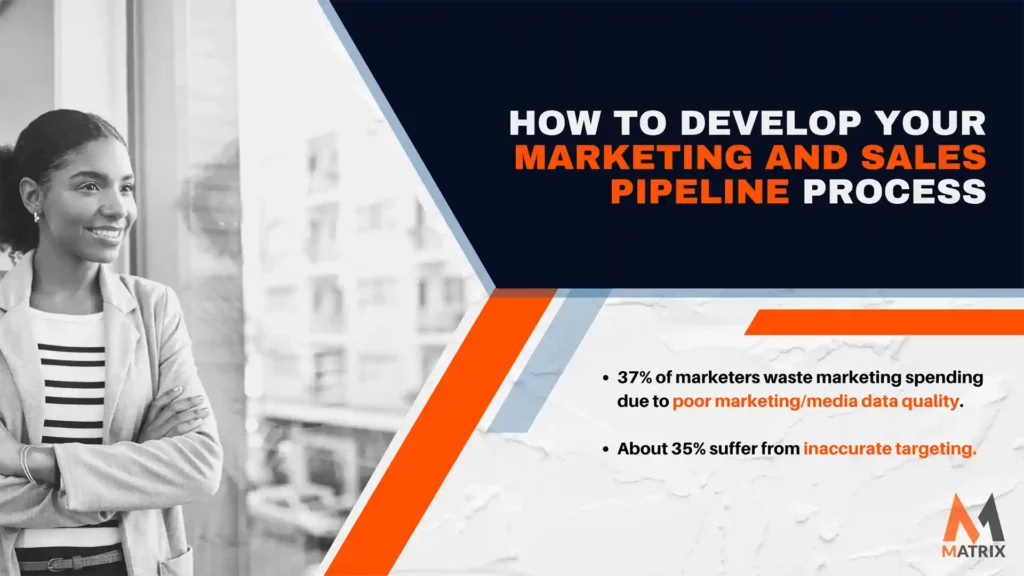Has your marketing and sales pipeline process been struggling?
Your marketing and sales pipeline process should be mapped out with a key sales conversation ratio at each stage. You must measure this to improve.
A sales pipeline is a visual representation of where potential customers are in the buying process. Conversions in this context refer to moving these prospects from one stage of the pipeline to the next, ultimately culminating in a sale.
The efficiency of this process directly influences revenue, making it a critical focus area for businesses aiming to boost their growth.
However, despite its importance, many companies struggle with optimizing their pipeline conversions, often due to a lack of understanding of the underlying principles and effective strategies.
The good news is that most of it can be designed as a workflow to help guide sales reps and marketers.
It works in an innovative supply chain and Six Sigma; now, we can apply the same principles to the revenue process. This is music to the ears of board members and CEOs of organizations.
Generating leads from your marketing channels will require researching each buyer’s journey, creating content tailored to each stage, setting metrics, analyzing the results, and adjusting your internal sales process accordingly.
You can automate this, which saves a significant amount of time.
There are marketing leads and sales leads, each with distinct parameters. Let’s explore the differences.
What is a sales pipeline?
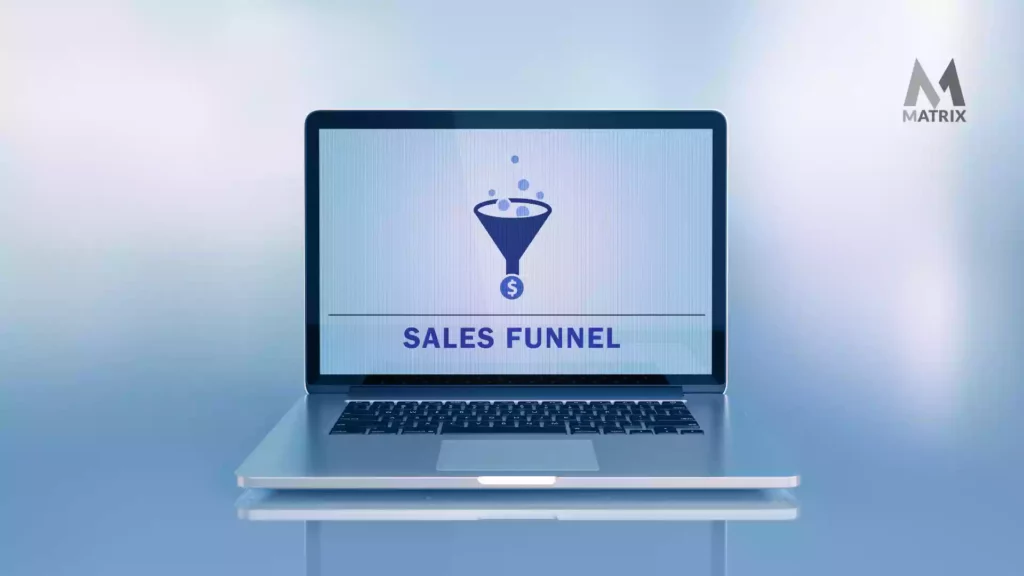
The sales pipeline is similar to a sales funnel. At the same time, the sales forecast can be developed based on the sales funnel, using conversion rates.
What is a Sales Pipeline? A sales pipeline is an organized, visual way of tracking multiple potential buyers as they progress through different stages in the purchasing process.
This information can help you identify which leads to focus on first, second, or third. The data can also help identify which prospects are interested in your company’s products or services and gauge their likelihood of making a purchase.
The sales pipeline can be visualized as a funnel with specific stages that move from top to bottom. This is helpful for sales teams since it quantifies and tracks progress toward reaching their revenue goals.
As an alternative to the sales pipeline, some organizations employ a waterfall approach, in which sales leads are assigned to specific salespeople and departments.
The sales process is often long and complicated.
This complexity makes it crucial for sales managers to utilize a sales pipeline.
A sales pipeline will help you track the entire process from start to finish, including which prospects are in what stage and how likely they are to move forward. It’s also helpful for ensuring that your company spends its time and resources on the right prospects. AIProdPad Product Development Transformation Through AI-Driven Innovation [White Paper]
Here is a sales pipeline example.
A sales pipeline can have many stages, but the most common include: – Lead -> Qualified lead -> Active Sales Opportunity = Proposal (or Agreement) -> Closed Sale or Lost Sale.
Sales pipeline examples help sales managers and salespeople track the performance of their sales teams. 10 Most In-Demand Types of SEO Services to Focus On in 2025
The Stages in the Sales Pipeline
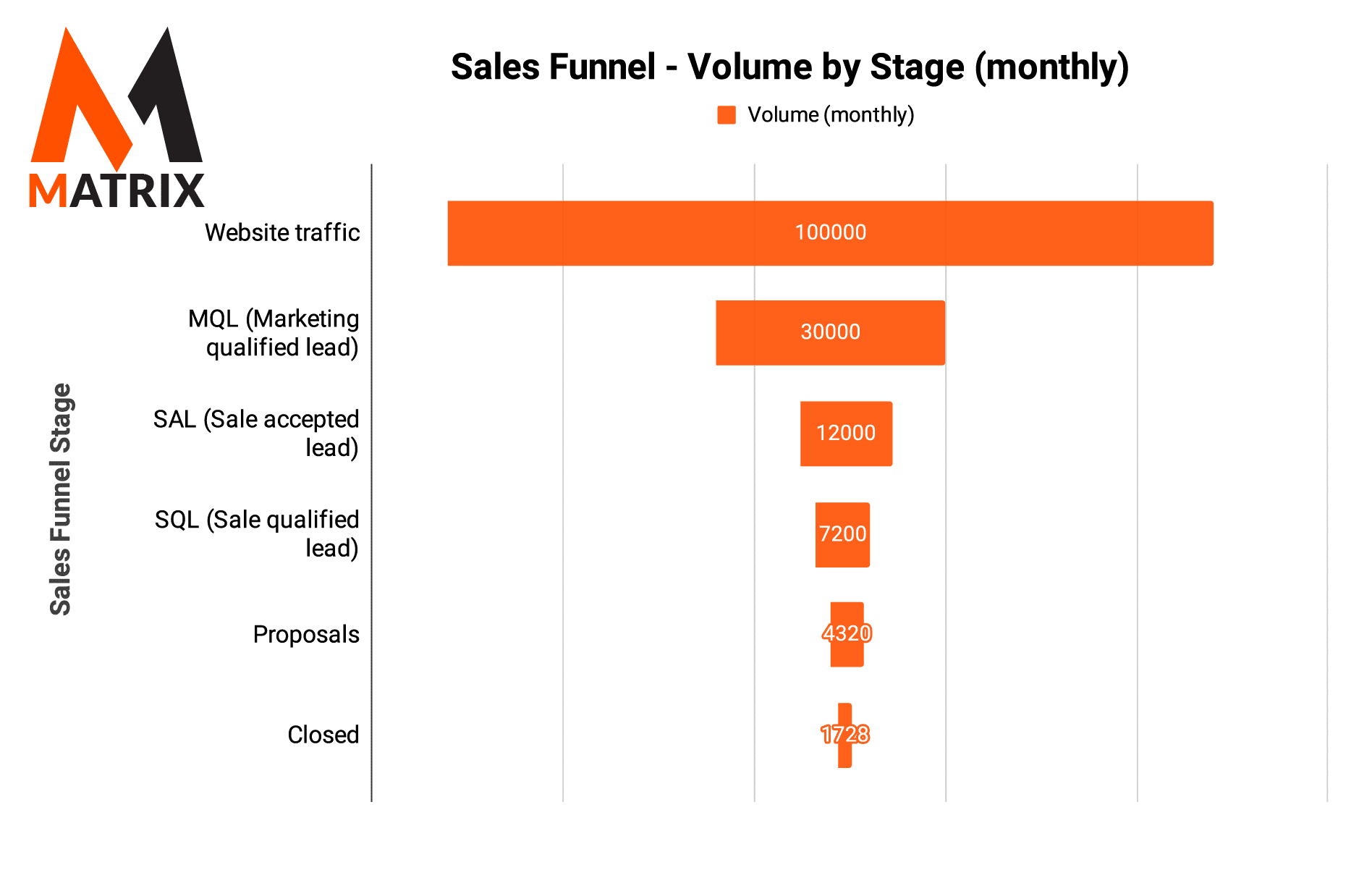
The stages of your sales pipeline depend on how your buyers buy from you. Skipping a step may result in lost sales.
Some businesses have multiple sales pipelines, depending on the products and other factors. What are yours?
The process begins with generating leads, which may be transformed into prospects depending on how you set your standards for qualification (i.e., whether a lead has already been qualified).
Leads are generated through various marketing activities and sales pipeline examples. Your sales team can follow up on the leads and convert them into prospects.
An effective sales pipeline example will outline the recommended time allocation for each stage of this process, from the initial lead generation to the prospect stage. As part of creating a sales pipeline example, you must clearly define a qualified opportunity for your business.
The Skill Gap: Why 85% of Marketers Are Not Ready
The Skill Gap: Why 85% of Marketers Are Not Ready highlights the urgent need for upskilling in a rapidly evolving digital landscape. Advanced technologies like AI, data analytics, and automation are outpacing traditional marketing expertise, leaving most professionals unprepared to adapt and compete effectively.
The sales pipeline example should include the following information:
- Relevant definitions and standards for each stage of the sales process;
- Metrics are used to assess potential sales opportunities. Depending on your business’s most important metrics, the metrics can combine financial and non-financial indicators.
Sales Pipeline Example Template
A good template for the sales pipeline example can be as simple as a table with four columns. This kind of sales pipeline example will include information on the following:
- source of leads and its qualification process;
- number and qualification time for each stage (i.e., how many days from the moment a lead is generated until it becomes qualified or in the prospect stage);
- The number of sales opportunities plotted on the graph includes how each stage can be further broken down, for example, by month.
Our sales pipeline example assumes you have a corporate website and need to track the leads generated.
The breakdown for sales opportunity generation will include data such as the prospect’s industry, type of business (e.g., B2B or B2C), and whether the prospect is a new or returning visitor to your website, among other relevant details.
The sales pipeline example template might look like this.

Sales Pipeline Example in Action
You may have heard about the story of one of our clients, an e-learning corporation producing specialized courses for the construction industry.
They had a sales pipeline example, a simple spreadsheet that provided insight into the effectiveness of their marketing efforts for lead generation.
However, after we created a custom-made template for them, they could get a more detailed analysis and make informed decisions about improving their lead generation process.
A Sales-Ready Leads Defined: The Marketing to Sales Hand-off
The marketing pipeline feeds your sales pipeline.
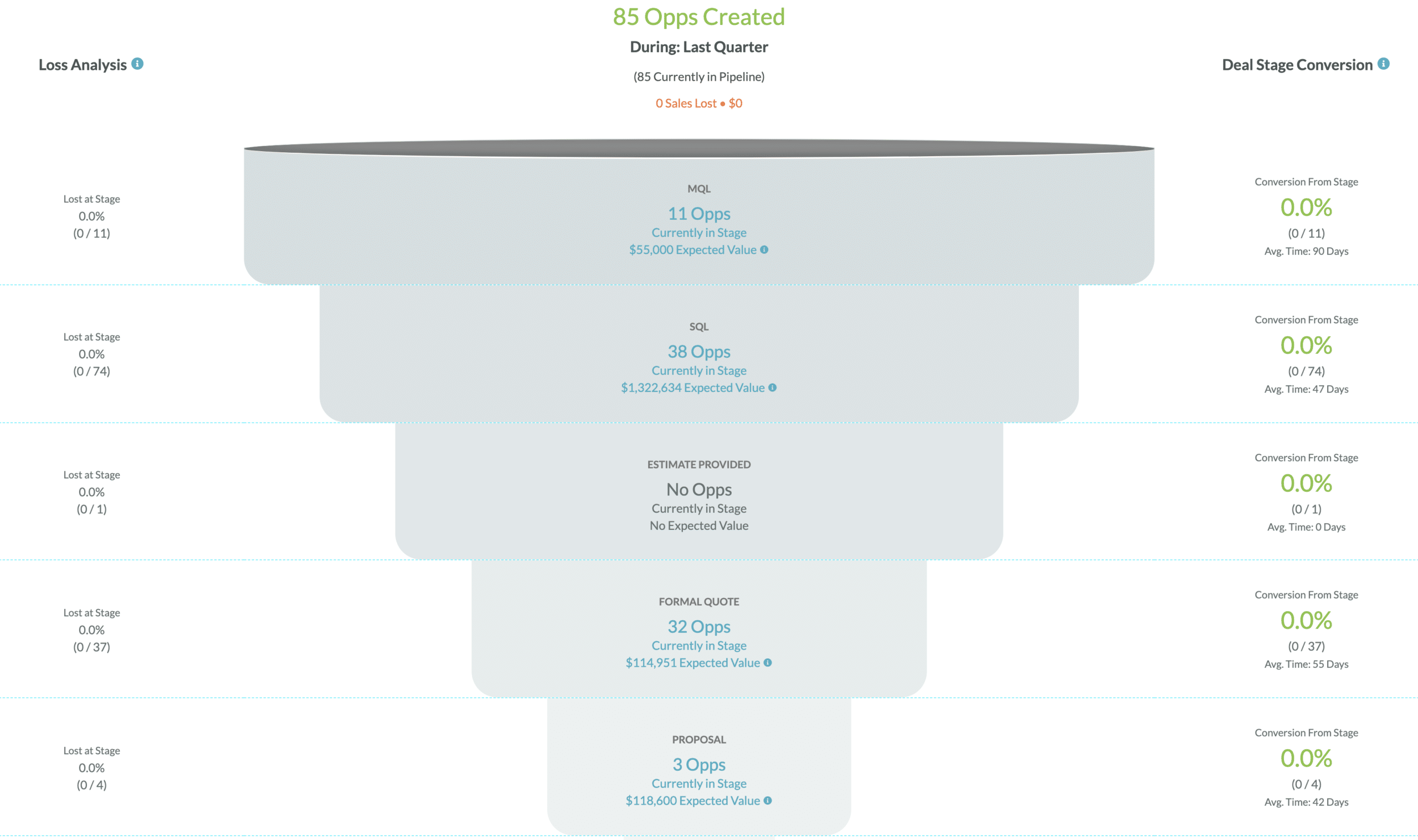
It is marketing’s role to create awareness and generate qualified leads (MQLs) before they are handed over to the sales organization as sales-ready leads.
How many lists must you weed out to get a qualified lead? How many people must you connect with to qualify for a need? How many qualified opportunities must you develop to write a proposal? How many proposals must you write to close a sale?
This is the science of sales! Because it integrates with the marketing process, it is essential to understand the health of your pipeline.
Many things contribute to the success of sales and marketing. Still, sales pipeline management is arguably one of the most crucial principles, especially in a tight and competitive market environment.
I will explore the marketing and sales process and explain how important a sales-qualified lead (SQL) is to the sales team.
- Do sales follow up on marketing leads? According to a study featured in Harvard Business Review, 71% of qualified leads are never followed up on.
- And leads that are followed up are only touched an average of 1.3 times. This represents a significant opportunity cost, not only in revenue but also in the customer or prospect experience.
The sales manager’s job is to ensure that each step of the sales process unfolds promptly. You must know which step you are in with any prospect.
The core of any process is that it is predictable and yields a certain result. The result changes when any step of your sales process is skipped or not completed on time. To establish the right plan and then follow it. By doing so, you’ll maintain control.
It’s important to remember that sales is a matchmaking process, and your marketing team’s role is to nurture prospects before handing them over to sales as a sales-qualified lead.
You want your sales representatives to focus on selling only to sales-qualified leads, so it’s essential to define what a sales-qualified lead (SQL) means for your company.
Sales and marketing success only comes when each side works toward shared goals. The first step is to determine the rules.
Drive Better Results with a Complimentary Marketing Audit
Take the guesswork out of your marketing strategy. Our Free Marketing Audit is designed to analyze your current efforts, identify gaps, and uncover growth opportunities. Whether you’re struggling with low ROI, limited engagement, or unclear targeting, we’ll provide actionable insights to help you achieve your business goals.

What are the 5 Lead Stages of the Sales Cycle?
The sales cycle is segmented into five distinct stages.
First, you should know each sales cycle stage and how they relate to your leads.
The sales cycle follows your leads through the buying decision process.
The diagram below illustrates a typical sales cycle for a high-tech consulting startup.
The lead stages typically follow this flow in the sales funnel:
- Prospecting [Attract] – Your lead has a problem; they search for a solution on the web but aren’t sure what they’re looking for yet. Your business appears in the prospect’s search results and has shown some interest.
- Top of the Funnel (TOFU) – Leads who visit your website and through TOFU content marketing (like white papers or industry reports) have found a potential solution to their problem. These leads are called marketing-captured leads (MCL) and must be qualified by the marketing team to become qualified leads (MQL) before being passed on to sales.
- Middle of the Funnel (MOFU) – Now that your lead knows what they need, they struggle with which company best fits their needs. You can encourage your lead to pick you up through MOFU offers. At this stage, some of the MQLs progress to the next sales funnel stage, known as sales-qualified leads (SQL), and the sales representative begins working on these.
- Bottom of the Funnel (BOFU) – Your lead has decided you’re the best fit, but needs to know why they should buy from you today. You can answer this question using BOFU marketing offers.
Delight—Your lead converted into a paying customer! Now, you must keep them engaged with special offers, social media shares, and excellent customer service, so that when it’s time to renew, they will.
What is the sales pipeline?
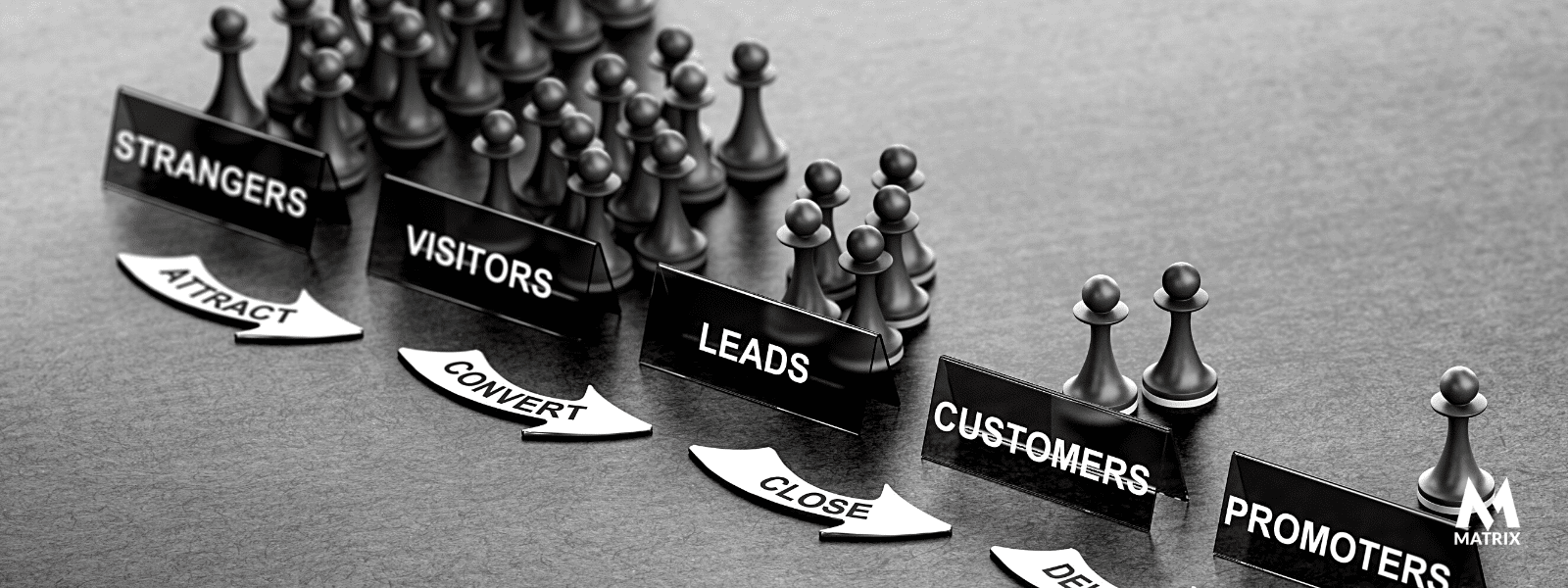
A sales pipeline visually represents sales prospects and their stages in the purchasing process.
The sales pipeline also provides an overview of a sales representative’s account forecast and how close they are to meeting the sales forecast and achieving quota.
You may need to revisit outdated tactics if your sales pipeline process has struggled to meet quotas. Your sales pipeline process should be audited to find performance gaps.
What is a Sales Lead?
Wikipedia defines a lead or sales-ready lead as “the identification of a person or entity with the interest and authority to purchase a product or service.”
Nowadays, the term ‘leads’ refers mainly to online leads generated by filling out a form online. However, they could equally result from a phone call or a business card from an interesting person at a networking event.
A lead typically consists of the contact details of a person, either a consumer or someone representing a company, who is interested in learning more about a product or service to purchase it.
What is a Sales Pipeline?
A Sales Pipeline is a visual representation of the steps a prospect goes through from first contact to becoming a paying customer. It usually breaks down the sales process into stages like:
- Lead generation
- Qualification
- Needs analysis
- Proposal
- Negotiation
- Closed-won or closed-lost
Each stage enables the sales team to track the current status of every opportunity, identify the necessary next actions, and assess the proximity of deals to closure.
What is a sales-qualified lead in sales? [SQL]
A sales-ready lead becomes a qualified lead, and it’s more than just a contact on a list you may have purchased or someone who recently filled out a form on your website’s landing page.
It includes further information about the person or company they represent, which qualifies them for a specific product.
At Matrix Marketing Group, we’ve adopted the BANT approach. I’m familiar with it from my IBM days, and it works.
Typical qualifying questions relate to the BANT approach:
- Budget: Do they have sufficient funds to purchase the product or service?
- Authority: Can they make a purchase decision?
- Do they need the product or service in question to fulfill their needs?
- Timescale: Do they have a specific time in mind when they wish to make a purchase?
By gathering answers to the above questions at the lead stage. These are then considered ‘sales qualified leads.’
Let’s delve deeper into the BANT or MEDDIC system.
The BANT System
The definition of an SQL may vary based on what you’re selling and who you’re selling to, but many companies use the BANT system (designed by IBM) when qualifying leads.
Here’s a breakdown of how to qualify leads using the BANT system:
Budget: Does a Prospect Have the Budget to Buy?
Effective selling requires that sales representatives (or SDRs) determine whether a prospect can afford their solution. It doesn’t matter how much a prospect likes your solution. They aren’t a viable customer if they can’t afford it.
Authority: Does a Prospect Have the Authority to Buy?
Good sales representatives know how to call high, but key executives have elaborate defense mechanisms to keep salespeople at bay. A personal introduction is the most reliable way to overcome these defenses.
Delegate this problem to the organization until someone knows someone who can pave the way. Meeting with lower-ranking individuals to gather intelligence before the introduction is acceptable, but the sales cycle does not formally begin until after this meeting.
Typically, B2B sales involve an average of 5.4 people in the decision-making process, so it’s essential to recognize a committee-based buying authority situation.
Need: Does a Prospect Require Your Solution?
Identify what you expect will be the executive’s major concern and present a thought-provoking point of view. Your goal is to engage an executive who does not know you in a serious dialogue and evoke some anxiety in them to solve the specific problem you are there to discuss.
You cannot afford to play safe as this will look like you are wasting their time; after all, when the executive agreed to the meeting, they did so to get some special insight into how to address their problem.
Matrix Marketing Group might not require our services if an organization hits all its sales targets. On the other hand, it may be looking to reduce costs and overhead, which is where our services also help a potential client.
The sales reps want sales-ready leads, often called sales accepted leads (SAL).
Timeline: When is a Prospect Looking to Make a Decision?
Timing is everything, but sometimes, it’s not the right time for the deal to close. And there are countless reasons. A potential lead may have been waiting for funding to proceed. Sales representatives must determine a prospect’s timeline before handing that prospect over to the sales team.
Let’s look at a real-world example from one of Matrix Marketing Group’s clients. They needed help fixing their sales-to-funnel leaks and improving their sales and marketing alignment.
One specific area of focus was the handoff from marketing to sales leads. Before we started, there was no specific hand-off from marketing-qualified leads to sales-qualified leads. If you are in sales, you know what I mean.
An inexperienced marketing team may hand over any leads from a trade show, complete a form, or call in for more information. These are not qualified leads and should be evaluated before allocating sales resources to them.
Their MQL to SQL ratio included the following:
- B: Software budget is > $50,000
- A: Meeting with CIO, CEO, or CFO
- N: Need is identified in the manufacturing space, and a problem with the supply chain
- T: Timing is < 180 days
Marketing has a clear definition and specific parameters before handing the lead to the sales team.
Let’s discuss sales-ready leads and who should qualify them.
Who Should Qualify Leads?

When sales reps have to qualify leads, it diminishes their closing power. Instead, leave lead qualification to a Sales Development Representative or a Marketing Development Representative.
Successful companies have experienced better results by separating their sales teams into clearly defined roles.
These roles include:
- Sales Development reps (SDRs) – reps that prospect for new leads
- Marketing development reps (MDRs) – reps that qualify leads from marketing campaigns
- Sales Reps – who close deals with sales-qualified opportunities.
- Your SD and MDRs should focus on creating steady opportunities for your sales reps to close.
Synchronize Your Sales and Marketing Teams for Better Sales Pipeline Process
Define your common goals and devise a plan to achieve them. Please ensure they’re specific and all point to generating revenue. When your goals are aligned, it’s much easier to work toward those common objectives.
According to a 2011 Aberdeen Group study, highly aligned organizations achieved an average year-over-year revenue growth of 32%, while their less aligned competitors experienced a 7% decrease in revenue.
Yet, according to another study by Forrester, only 8% of companies report having a tight alignment between sales and marketing. So, the benefits of aligning the two groups are clear.
Sales and marketing alignment is not a “touchy-feely” relationship problem, nor should it be viewed as an expected result of different personality types. It starts with sales-ready leads and at the handoff of the lead.
Ensure your sales and marketing teams are aligned regarding the lead handoff. Sales want qualified leads and active buyers.
I’d love to hear your comments about sales-ready leads.
HOW MANY LEADS DO YOU NEED TO REACH YOUR SALES GOALS?

Calculate your marketing leads forecast with this FREE marketing funnel calculator. See How Many Leads You Need
We all know that sales and marketing have undergone significant changes, and I’ve been arguing this for the last two decades. It’s time to ensure that our sales teams understand the new process.
Today, you’ll learn how to build a sales and marketing powerhouse. This article is designed for entrepreneurs, CMOs, marketing directors, VPs of Sales, and CEOs.
It would be best if you took some notes. Everyone reading will take away at least two to three ideas you can use immediately.
What are industry benchmarks for BANT in technology, travel and hospitality, and manufacturing companies?
BANT (Budget, Authority, Need, Timing) is a widely used framework for lead qualification. While exact industry benchmarks vary, here’s a general breakdown of how BANT benchmarks apply across technology, travel and hospitality, and manufacturing sectors:
1. Technology (SaaS, IT Services, Software)
- Budget:
Benchmark: ~60–70% of qualified leads have a defined or allocated budget.
Insight: Tech buyers often have annual budget cycles; funding is clearer in Q1 and Q3. - Authority:
Benchmark: Approximately 50–60% of leads have direct decision-making authority or strong influencer influence.
Insight: Often involves committees (IT + Procurement + Business Stakeholders). - Need:
Benchmark: ~70–80% of qualified leads have an active pain point or project.
Insight: Needs are tied to efficiency, scalability, or compliance pressures. - Timing:
Benchmark: ~30–50% of opportunities have a decision horizon <6 months.
Insight: Mid-to-long sales cycles (6–18 months are common for enterprise tech).
2. Travel & Hospitality (Vendors, Platforms, B2B Services)
- Budget:
Benchmark: ~50–60% of qualified leads have budget clarity.
Insight: Often seasonal; tied to occupancy rates or major tourism seasons. - Authority:
Benchmark: ~40–50% of leads reach true decision-makers.
Insight: Small chains may make decisions quickly, while large groups often defer to corporate. - Need:
Benchmark: ~60–70% have pressing marketing, booking, or guest experience needs.
Insight: Needs spike pre-season or around expansion events. - Timing:
Benchmark: ~25–40% are ready to act within 3–6 months.
Insight: Many projects align with seasonal business calendars.
3. Manufacturing (OEM, Industrial Equipment, Components)
- Budget:
Benchmark: ~55–65% of qualified leads have pre-approved budget or CapEx allocation.
Insight: Strong alignment with annual procurement or engineering cycles. - Authority:
Benchmark: Approximately 50–60% of leads include Engineering Managers, Directors, or Operations VPs.
Insight: Often collaborative decisions involving Engineering + Purchasing. - Need:
Benchmark: ~60–75% have a spec-defined need or are replacing legacy equipment.
Insight: Demand triggered by regulation, supply chain issues, or obsolescence. - Timing:
Benchmark: ~35–55% aim to implement within 6–12 months.
Insight: Lead times, approvals, and supplier vetting can extend the cycle.
Strategic Implication
If you’re using BANT to score or route leads, adjusting thresholds by industry is critical. For instance:
- In tech, a fast “Timing” window may be unrealistic for large deals.
- In manufacturing, “Authority” may require mapping both technical and procurement influencers.
- In travel, “Need” is often context—driven by seasonality or occupancy goals.
Here is a BANT Scoring Matrix tailored for each industry (Technology, Travel & Hospitality, and Manufacturing), ready for CRM or lead scoring systems.
✅ How to Use This Matrix:
- Each BANT category (Budget, Authority, Need, Timing) is scored on a 0–3 scale.
- Leads scoring 9 or above out of 12 are considered Sales Qualified Leads (SQLs).
- This framework can be implemented in CRMs like HubSpot, Salesforce, or via lead scoring tools.
Technology Industry: BANT Scoring Matrix
| Criteria | 0 Points | 1 Point | 2 Points | 3 Points |
|---|---|---|---|---|
| Budget | No budget | Exploring options | Tentative budget allocated | Approved budget in current cycle |
| Authority | No contact with decision-maker | Influencer only | One decision-maker looped in | Final decision-maker engaged |
| Need | No pain identified | Curious/researching | Clear interest in solution area | Urgent pain, active project |
| Timing | >12 months | 6–12 months | 3–6 months | <3 months or RFP issued |
Travel & Hospitality Industry: BANT Scoring Matrix
| Criteria | 0 Points | 1 Point | 2 Points | 3 Points |
|---|---|---|---|---|
| Budget | No clarity or budget | Considering next season | Budget likely approved | Budget approved this season |
| Authority | Front-line contact | Mid-level manager | Department head involved | Owner or executive decision-maker |
| Need | No clear need | General improvement interest | Specific upgrade (booking, ops) | Time-sensitive demand (e.g., season launch) |
| Timing | >9 months | 6–9 months | 3–6 months | <3 months or urgent (e.g., before peak season) |
Manufacturing Industry: BANT Scoring Matrix
| Criteria | 0 Points | 1 Point | 2 Points | 3 Points |
|---|---|---|---|---|
| Budget | No funds / not discussed | Exploring ROI | CapEx request in process | Budget confirmed in CapEx cycle |
| Authority | Junior engineer or buyer | Influencer (e.g., PM) | Engineering or Ops Manager involved | Engineering Director or Procurement Head |
| Need | No defined need | Early stage idea or upgrade | Equipment nearing end-of-life | Specs or RFQ ready |
| Timing | >12 months | 6–12 months | 3–6 months | <3 months or build schedule committed |
🧩 Optional: CRM Implementation Tips
- Add dropdown fields or radio buttons in your CRM for each BANT criterion.
- Use automation rules to calculate the total score and route leads accordingly.
- Consider tagging leads as Cold (0–5), Warm (6–8), Hot (9–12).
What’s wrong with traditional marketing and sales process pipelines?

Your sales pipeline process is critical for sales success.
Sixty-six percent of marketers state that companies will not succeed unless they have a digital marketing approach, and most marketers agree that marketing has tangible, quantifiable value (Adobe).
Marketing has changed more in the last two years than in the past 50. Digital marketing approaches are typically in a constant cycle of trial and error.
So, what are the top goals for marketing and sales teams? What does your sales team want? At the end of the story, they want higher-quality leads.
Sales leads that have been nurtured before they’re handed off to the sales rep. You need a marketing attribution model to help tune marketing campaigns and demonstrate the ROI of achieving those results.
Let’s look at where the gaps occur. There are three primary gaps: a talent gap, a technology gap, and a strategy gap. All of these lead to the typical performance gap. Capgemini states that 90% of people lack the digital skills to implement an effective digital strategy.
A simple example is the technology gap in the adoption rates of marketing automation.
It has a sixty percent adoption rate in companies with over $500 million in revenue. It drops to ten percent with revenues between $25 million and $500 million and almost entirely tails off at five percent between $5 million and $20 million.
What does this mean? These companies have a high output, ranging from $20 million to $500 million, to leverage technology.
Finally, the strategy gap: It’s easy to get caught up in the next big thing, such as Snapchat, artificial intelligence, account-based marketing (ABM), and inbound marketing, but these are all buzzwords that are meaningless without a well-planned digital strategy that will help drive qualified leads.
Companies Waste Up to 40% of Their Marketing Budget on Poorly Targeted Campaigns
Poorly targeted marketing campaigns, including those driven by outdated data or vague buyer personas, can waste up to 40% of marketing budgets annually. This highlights the need for better data management and audience segmentation strategies. (HBR)
The modern buying process
So, let’s review how the modern buyer has shifted the sales process. The modern buyer has changed the way the sales process is curved forever. Have you ever purchased something online?
Your sales pipeline process is critical for success and must map how people buy.
Have you ever used social media to ask a question? Maybe on Facebook to a friend or on LinkedIn? Well, I sure have. I do it all the time.
Before, internet buyers were relatively uninformed; their journey was pretty much a straight shot triggered when customers recognized their needs.
The trigger can be random, and the buyer can conduct research. The standard wisdom is that sales are an art rather than a science, which might be why so many great ideas have gone from the startup phase straight to the graveyard.
Building the next 100 million dollar business requires a sales team to do the job reliably. Looking at the customer journey, 59% of B2B buy your site.
According to Forrester, they don’t even want to interact with a sales representative as a primary research source. Thus, 57% of the traditional sales cycle is completed without interaction with your company.

What do you do? You’ve got to get in front of this 57% number while the customers are doing their due diligence, and you can do that with content. The current industry trends and the analysis tell us that change is necessary.
Does your sales team know about this, and does management understand these changes?
I speak to C-level executives who know that sales productivity is paramount to enabling a company to grow. However, they are still using the same outdated sales tactics to survive. 71% ranked it as the most critical importance.
It all starts with understanding who you’re trying to reach. We can see the whole picture of customers’ buying and internal sales cycles (sales pipeline).
Once I understand the customer’s buying cycle, I can see how they correlate. Only then can I begin to align our sales process cycle. For example, if I’m going to target a buyer who is exploring, we want to give them something that will help them make an informed decision with content and context.
In other words, hit them with what matters at that specific time. It’s not until you understand this process that you can start building your digital marketing plan.
Start to think about the parameters that make up your ideal customer. You must understand demographics and psychographics; it’s all part of the process, but it goes beyond the typical persona. Use criteria like:
- Employee size
- Industry
- Geography
- Department size
- Revenue
- Job titles
Next, you’ve got to understand the individual’s job. What tasks are they trying to complete, and what are their responsibilities? Let’s take manufacturing as an example. Are your inventory turns reducing WIP on the floor? You have to know their job and what they need to do.
After gaining an understanding, move on to the customer’s pain points. These are anything that annoys your customers before, during, and after trying to complete a project. You need to figure out these for your target markets.
Finally, customer gains are described as outcomes and benefits for your customers and what they want. These include utility, social games, career growth, or cost savings.
This is where you begin to build out your product offerings. Now, a customer profile describes a particular customer segment in your business model. In a more structured and detailed way, it breaks the customer down into job pains and gains.
Sales and marketing alignment and the sales pipeline process
Face it. There’s friction between the sales and marketing teams. It’s human nature, but it must be addressed. Sales and marketing alignment typically impact enterprise organizations.
However, I’ve seen it in all sizes. Sometimes, it’s like sales and marketing teams are from Venus and Mars, and this friction is caused by economics, culture, or both. Next, understand your target markets. Knowing their buying cycle is critical. Do your sales reps have a systematic approach to selling?
As a product manager, I learned that consulting my colleagues on the manufacturing shop floor would save time and money rather than just submitting new designs.
It wasn’t enough to coexist, not when we could work together to create value for the company. More importantly, it provided increased value for our customers. You would think the marketing and sales teams worked so closely and interconnected that they would also discover this.
Building a feedback loop is important to see how you’re doing and where the bottlenecks occur and correct them. It’ll reduce your sales cycle and get your teams on the same page. When the buying cycle aligns with your sales cycle, you’ll see reduced time to sale and higher closed ratios.
When we review the sales pipeline for these three different-sized companies in the same industry, we can see a simple sales cycle for the enterprise, midsize, and small businesses.
The mid-market group generated 8,000 leads passed over to sales in Q1; 6% of those leads had converted customers for 480. The average annual deal size for each client was $175,000.
With this conversion data, we can start optimizing the stages, but let’s look at the small business leads and specifically pick the leads-to-customer ratio. Looks pretty good. Not so fast here. We might be waiting too long to contact these leads.
This theory can be tested. Get in front of the leads early and see what happens. Does your leads-to-close ratio increase? If I do that and see a 5% lead-to-sales ratio bump, I’ve added 550 more customers. With $22 million of incremental revenue, it’s not bad for a simple change, right?
Make your website your best sales rep.

If we switch gears slightly, is your website optimized with a keyword strategy, and when did you last complete a redesign? What is your site’s goal? Is it branding, e-commerce, educating customers, or lead generation? When was the last time you did a website audit?
Google frequently updates its search algorithm, and it’s essential to understand how these changes impact your site. Most people have no idea how their website is performing.
A typical static website is built on platforms like Drupal and WordPress, but did you know that you can develop a website that changes according to your users’ preferences?
These are called dynamic websites, which present content tailored to each user group. It doesn’t have to be based on a buyer persona either; you can use criteria like where they are in the buying cycle or their location, if you have multiple physical stores.
Even more important is utilizing a responsive website design platform that automatically optimizes for visitors from any device. Responsive design is automatically optimized for mobile devices and includes built-in SEO.
Optimize your website with SEO, incorporate your keywords, and include them in your header, title tag, meta description, and alt tags. Design your website to funnel people to your highest-converting web pages. You
You can find the top-converting web pages by setting up goals in Google Analytics.
Content That Converts: Transparent Pricing for Maximum ROI
Explore Matrix Marketing Group’s Flexible Pricing Plans for Premium Content and Marketing Solutions Tailored to Your Goals.
Content Marketing Works
I love Hotjar; it’s an excellent tool for evaluating user experience. I’m sure you’ve heard the term “inbound marketing.” Inbound marketing is a marketing strategy that enables buyers to find you online.
Would it be beneficial if people searching for help could find you with content that answers their questions without requiring a prior conversation, allowing them to be ready to buy when they’re ready? That’s the power of inbound marketing, paid with a solid content marketing plan.
Get your sales representatives involved in the process and ask the typical questions they receive from their prospects. Where is the bottleneck in the sales pipeline?
Look for common themes and topics to develop a keyword strategy that maps to those words. Your audience uses this so that you can write with those in mind. We’re all busy, but you have to find the time to publish at least two blogs per week and establish a content production process.
It’s crucial to develop content that your audience is willing to pay for. To be good at this, you’ve got to think like a journalist. I use a content key, which is an editorial framework divided into three categories. I call it the head, the heart, and the hands.
The head is thought leadership content, the heart is innovation strides and customer stories, and the hands are functional pieces, such as how-to articles. It’s a simple way to remember the guiding principles behind our content creation.
A strong editorial mission explains who you’re trying to reach and how to serve them with content. These include who you are as a company, who you’re working to reach, how you will reach them, and what you want to accomplish when you do reach them.
Don’t let it get too complicated at the beginning. Use a simplistic buyer’s journey and write content that aligns perfectly.
Think of it this way: if you want to lose 10 pounds, you work out hard, diet for a month, and then meet your goal. Boom, 10 pounds are gone. You stop doing that routine. The same reaction applies here. Don’t expect it to happen overnight, and it’s a commitment that will pay off.
Companies that publish 16+ blog posts per month get almost 3.5 times more traffic than those that publish zero to four monthly. Here’s a representation of an uncomplicated buyer journey.
Once I understand my buyer’s journey, I can develop marketing content to help generate new leads and nurture leads in my sales pipeline.
I use prescriptive content, thought leadership, and brand or product content.
As I built out this slide set, I wanted to ensure that what I was saying was accurate, so I went to Google and typed in “why hire a marketing agency” to see what came up. We’re number two on that page. Content works.
Now that you have your content and are starting to create an editorial calendar, you need to amplify your message. You know where your customers are consuming information about your industry solutions to solve their issues, and what publications, both in print and online, they read.
The sales pipeline process will require different content depending on the buyer’s stage in the cycle.
Which top influencers does the sales team know? Does an outbound strategy still work? Be cautious; personalized emails are most effective, and we’ve seen a 20 percent increase in response rates with this approach. What is your reach today, and how do you grow it for sales leads?
Develop content that your audience wants and use landing pages to capture their information. If you’re starting, consider trying PPC (pay-per-click) campaigns and be sure to use negative keywords to avoid attracting irrelevant clicks.
There are over 10,000 technology platforms for sales and marketing. This slide comes from marketing technology guru Scott Brinker.
This slide can be overwhelming, and not all technology applies to every business. However, you must prioritize a technology rollout if you are going to employ a digital marketing strategy. Not only will you save time, but you’ll align your offerings with your buyers. Most importantly, you begin to boost sales, shorten your sales cycles, and build your sales pipeline.
It’s time to take a look at analytics and reporting. Set up smart marketing goals. Also, be sure to do that for your sales pipeline as well. You can visit our resource page and download some free templates if you’re unsure where to start.
After goals are established, develop a marketing attribution model. Gather and analyze your sales pipeline and marketing attribution model data, and review which marketing channels and programs are working effectively.
The sales pipeline process is easily monitored and analyzed to identify bottlenecks.
Even more importantly, attribution tells us which marketing efforts are not working. Test and tune your marketing programs to maximize your return on investment.
My day starts here in the marketing dashboard.
Here, I can identify gaps and determine if the sales pipeline process could be improved.
These are some of the regular reports I use daily, and they are right at my fingertips. At Matrix, we utilize HubSpot to help build our sales pipeline, and we have it configured to send daily snapshots and detailed reports automatically.
The magic begins when you combine and align sales, marketing, and technology. Strangers become leads, leads become customers, and your business grows.
I hope you’ve taken away two to three ideas from this webinar. You can begin by evaluating your client’s buying cycle and aligning it with your internal sales cycle.
Then, develop your content marketing plan and get an independent marketing assessment. Thank you for watching. We’re offering a free website audit and a comprehensive free marketing assessment for anybody interested.
Marketing vs. sales pipeline leads to the accountability of the ROI and sales pipeline stages.
There’s nothing to lose; it’s all free. Pipeline marketing examples are readily available on the web.
We’re listening to what you have to say about the sales pipeline process
Do you have any feedback on the sales pipeline process? Please share it with us on Facebook, Twitter, or LinkedIn.




FAQs for Modern Marketing and Sales Pipeline Process
What is a modern marketing and sales pipeline process?

A modern marketing and sales pipeline process is an organized framework for generating leads, nurturing them through the buyer’s journey, and eventually converting them into paying customers. This process typically involves multiple stages of lead generation, qualification, nurturing, and closing and includes several metrics to measure the effectiveness of each stage.
What are the benefits of a modern marketing and sales pipeline process?

Improved visibility into the customer journey – The ability to track leads through all pipeline stages allows organizations to understand better how customers move through their sales and marketing funnel. Increased efficiency – Automating repetitive tasks such as lead qualification and nurturing can help streamline operations and increase productivity and better customer experience – By understanding each customer’s journey, organizations can create more personalized experiences that improve customer satisfaction.
How do I create a modern marketing and sales pipeline?
Creating a modern marketing and sales pipeline involves several steps, including Establishing goals – Defining clear objectives for each stage of the pipeline helps to ensure that the process is optimized for success. Developing strategies – Good marketing and sales strategies should be based on a thorough understanding of customer needs, behaviors, and preferences; Setting up technology infrastructure – Leveraging powerful tools to automate lead qualification, nurturing, and closing can help organizations stay organized and efficient; and Measuring performance – Regularly tracking and analyzing pipeline metrics can help organizations identify areas for improvement and optimize their process.
What types of tools are used in modern marketing and sales pipelines?

Modern marketing and sales pipelines typically use automation tools, analytics software, customer relationship management (CRM) systems, email marketing platforms, and more. Automation tools help streamline processes, while analytics software helps measure performance. CRM systems store customer data and manage leads throughout the pipeline. Email marketing platforms enable organizations to send personalized messages and nurture leads.

